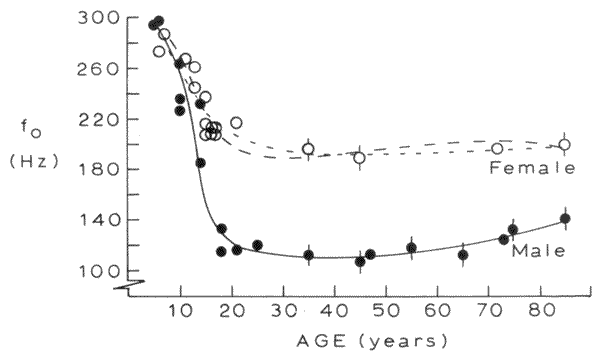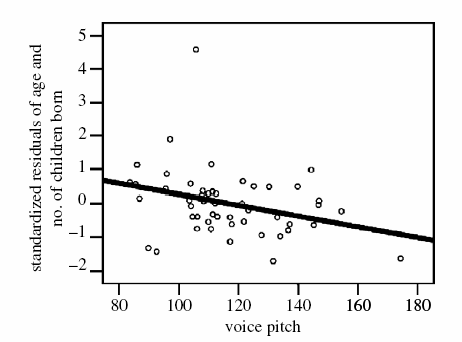September 29, 2007
The Barry White effect
You've probably seen the news coverage: "Deep-voiced men 'have more kids'", says the BBC (and Newsweek uses the same headline, minus the quotes); "Women may favor men with deep voices", says Science Daily; "Deep-voiced men make more babies", says AFP; "Barry White's Secret", says the Guardian; "Men with deep voices may be more fertile", says the Boston Globe; "Women prefer men with deep voices", says The Telegraph; "Deep voices equal more babies", says Fox News; "Deep-voiced men likely to have more children", says Reuters.
I'm happy to say that these news stories are focusing, for once, on a sex difference in humans that actually exists, and really is under genetic control. Men do have lower voices than women, by a proportion that is on average much greater than the overall difference in size between the sexes. And this particular form of sexual dimorphism is apparently not shared with our relatives the chimps and gorillas, so it must have evolved during the same period that human speech and language did.
Therefore, starting at some point during the last five million years or so, there must have been a selective advantage for male hominins with lower voices. And according to the featured study (C.L. Apicella, D.R. Feinberg, F.W. Marlowe, "Voice pitch predicts reproductive success in male hunter-gatherers", Biology Letters, published online 9/25/2007), evidence of this selective advantage can still be found today.
Their abstract:
The validity of evolutionary explanations of vocal sexual dimorphism hinges upon whether or not individuals with more sexually dimorphic voices have higher reproductive success than individuals with less dimorphic voices. However, due to modern birth control methods, these data are rarely described, and mating success is often used as a second-rate proxy. Here, we test whether voice pitch predicts reproductive success, number of children born and child mortality in an evolutionarily relevant population of hunter-gatherers. While we find that voice pitch is not related to reproductive outcomes in women, we find that men with low voice pitch have higher reproductive success and more children born to them. However, voice pitch in men does not predict child mortality. These findings suggest that the association between voice pitch and reproductive success in men is mediated by differential access to fecund women. Furthermore, they show that there is currently selection pressure for low-pitch voices in men.
What Apicella et al. did was to collect "voice recordings and self-reported reproductive histories" from "49 men between the ages of 19-55 (M=38.18; s.d.=11.38) and 52 women between the ages of 18-53 (M=32.71; s.d.=9)", recruiting from nine camps of the Hadza people, who are hunter-gatherers living on the savannah in Tanzania. The cultural background:
[The Hadza] number approximately 1000. Women dig for tubers and gather fruits, while men mainly collect honey and hunt animals. Marriages are not arranged, so both sexes are free to choose their spouses, though the approval of their parents is often sought. The Hadza are mostly monogamous although approximately 4% of men have two wives [...]. The divorce rate is fairly high [...], so the mating system can be best described as serial monogamy. Approximately 20% of Hadza stay married to the same person their whole life, and divorce when it occurs is often the result of women not tolerating men's extramarital affairs [...]. Women's extramarital affairs appear to be mostly the result of women deciding to take new husbands when their old husbands leave camps for extended periods of time ...
It's important that the statistical effects of male voice pitch were apparently not simply the result of a selective advantage for larger men; and indeed the researchers didn't find any effect of various measured size differences:
Anthropometrics including height, weight and upper-arm muscle mass were also collected but are not reported here, since they do not predict any reproductive outcomes in either sex after controlling for age, and did not significantly increase the r2 values in the models reported below.
All that said, we need to observe that the effect of voice pitch was a statistical tendency, a much weaker effect than I'll bet most readers of the news stories are imagining. (Those stories exaggerated and sensationalized the results of this study; in other news, the sky is still often said to be blue, and water is still widely reported to be wet.)
Here's a graph from Apicella et al., showing number of offspring plotted against voice pitch, after correcting for age:
Fig. 2: Residuals from regression of the number of children born on age plotted against voice pitch. This scatter plot shows a negative relationship between male voice pitch and the number of children born. Note that this relationship remains unchanged when the person with most children born is removed from the analysis.
The two factors of age and voice pitch explained about half of the variance in number of children that men report were born to them (r2=0.505). The authors don't report what fraction of the residual variance is accounted for by voice pitch, after the linear effects of age are taken out.
The authors feel the need to reassure us that the "this relationship remains unchanged" when the one outlier guy with many kids (just under 5, in the plot above, after correcting for age) was taken out. (The Reuters story says that he had ten kids, and calls him "the man in the study with the deepest voice", which is an obvious falsehood.) There's another outlier -- that one guy with an average voice pitch of about 175 Hz, whose residual number of children was negative two after correcting for age. With both the super-daddy and the counter-tenor removed, the relationship in that scatterplot is going to look a lot less impressive, though probably there is still an effect.
[Let me climb on my soapbox for a minute, and rant about how there's no excuse for journal editors not to require authors to provide full tables of their data, not just scatter plots and statistical test results. Then we wouldn't have to speculate about things like this.]
As the authors suggest, there are several different possible lines of causation here. The most obvious one is sexual selection (the "Barry White effect"):
Most studies have found that women find lower pitch male voices to be more attractive [...] and judge them to be more dominant, older, healthier and more masculine [...] , while men find higher pitch voices in women to be more attractive, subordinate, feminine, healthier and younger [...] . Furthermore, women's preferences for low-pitch voices in men are greater in the fertile phase of the menstrual cycle [...] and when judging for short-term sexual relationships [...] , suggesting that low voice pitch, like other masculine traits, may signal mate quality [...] .
But male pitch is also correlated with testosterone levels (since it's pubertal response to testosterone that lowers it):
... studies have found that high testosterone levels predict low voice pitch in adult men [...] , and that voice pitch is causally linked to pubertal testosterone levels [...]
and so the (small) reproductive advantage of voice pitch might be the result of other effects of differential testosterone levels, rather than the effects of voice pitch as such.
Whatever the mechanisms of the selective effect, it's certain that there must have been one, and it's pretty clear that it started after the genus Homo separated from the other hominids. It's plausible that this was part of the process that led to human speech and language -- Darwin thought that vocal courtship displays probably came first, and I tend to agree with him:
... [I]t appears probable that the progenitors of man, either the males or females or both sexes, before acquiring the power of expressing their mutual love in articulate language, endeavoured to charm each other with musical notes and rhythm.
On this view, speech is music plus semantics. Whatever the sequence, it would interesting to know just when hominid laryngeal sexual dimorphism evolved -- and we should in principle be able to figure that out, now or not too far in the future.
We would need to know which genomic variations are responsible for the effects of testosterone on larynx growth during puberty in humans (unfortunately, I don't think that anything about this is now known.) Then we could use phylogenetic reconstruction methods to estimate the time depth of the innovation. The estimates would have all the problems that such estimates generally do, and the even an accurate date for the change(s) would be susceptible of several different interpretations. But still, it would be a step forward.
If you're interested in more background, here's the section on the larynx from the lecture on Language and Gender in my lecture notes for Linguistics 001 at Penn:
Posted by Mark Liberman at September 29, 2007 07:11 AMThe larynx
Males and females differ little in stature before puberty, but post-pubescent males are about 8-9% taller. According to a database maintained by NIST, the male children in their sample averaged about 3% taller at age 2, and less than 1% taller at age 10, whereas males average about 9% taller at age 18. According to a 1977 publication from the National Center for Health Statistics, at age 2 the 50th percentiles for males and females are identical; at age 10, girls are .6% taller (in the 50th percentile), and at age 18, males are about 8% taller.
With respect to the length of the vocal folds (the tissue in the larynx that is responsible for producing voiced speech), this overall difference between the sexes is magnified by approximately a factor of seven: the vocal folds of post-pubescent males average about 50-60% longer than those of females of the same age (length of the overall glottis or length of the anterior glottis in the figure and table below)..
Top view of the vocal cords
anterior commissure tip of vocal process angle of bilateral vocal folds at AC glottic width at vocal process level length of entire glottis length of anterior glottis length of posterior glottis length of membranous vocal fold
AnAC in degrees LMF in mm GWP in mm LAG in mm LPG in mm LEG in mm (Data and picture from Hirano, M, K Sato and K Yukizane; "Male-female difference in anterior commisure angle", in S. Kiritani, H. Hirose and H. Fujisaki, Eds., Speech Production and Language, Mouton de Gruyter, 1997. The study involved excised larynges from 10 males and 10 females, average age 58 for the males and 66 for the females)
As a result of these laryngeal changes, adult human males have significantly lower voices than females do, out of proportion to their rather small different in average height. Though the pitch of anyone's speech depends very much on circumstances, under comparable conditions, (adult) human females voices are likely to show pitches roughly 75% higher those of male voices. This difference reflects not only the difference in vocal cord length, but also a difference in vocal cord mass -- and perhaps some socially-conditioned factors as well. A graph showing data from various studies is reproduced below (taken from Kent 1994):

Because the larynx also drops lower in the neck in post-pubescent males, the overall adult male vocal tract length is about 15% longer on average. This means that resonance frequences (including the formant frequencies that determine vowel quality) are also about 15% lower in adult males as compared to females. This is about 175% of the difference expected on the basis of the average overall size differences (8-9%). This difference also means that adult males are even more subject to the risk of choking on aspirated food that is a price the human species pays for adapting its vocal organs to speech.
None of the other species of apes shows a similar sexual dimorphism of the vocal organs, although overall size differences between the sexes tend to be larger in other apes than in homo sapiens.

